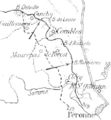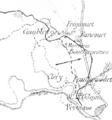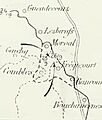Capture of Combles facts for kids
Quick facts for kids Capture of Combles |
|||||||
|---|---|---|---|---|---|---|---|
| Part of The Battle of the Somme, First World War | |||||||
 Battle of the Somme 1 July – 18 November 1916 |
|||||||
|
|||||||
| Belligerents | |||||||
| Commanders and leaders | |||||||
| Douglas Haig Joseph Joffre |
Erich von Falkenhayn | ||||||
| Strength | |||||||
| British: 2 brigades French: 1 regiment |
3 regiments | ||||||
The Capture of Combles was an important event during the Battle of the Somme in the First World War. It happened on September 25–26, 1916. Combles is a small village in France. It was a key location for the German army. They used it to store supplies and shelter soldiers.
British and French forces worked together to capture Combles. This battle was part of a larger attack called the Battle of Morval. The capture of Combles was a victory for the Allies (British and French). It helped them move forward in the Somme region.
Contents
Why Combles Was Important
Combles in 1914
In September 1914, early in the war, there was fighting near Combles. French and German troops clashed. The German army pushed the French back. Combles then became a quiet area for a while.
Combles in 1916
By 1916, Combles became very important again. It was a safe place for German soldiers to rest. They also stored lots of supplies and equipment there. The Germans built strong defenses around the village. These defenses were part of their third main line.
British and French planes flew over Combles. They saw the strong German positions. Allied forces started bombing the village. They hit a German ammunition train. This caused a huge explosion.
French troops began to advance closer to Combles. They captured high ground nearby. British forces also pushed forward. They captured a key area called Falfemont Farm. This helped the British and French armies connect their lines.
Bad weather and supply problems slowed down the French. But they kept pushing towards Combles. They captured more areas around the village. By mid-September, Combles was surrounded on two sides. The British were to the north. The French were to the south.
Preparing for the Attack
British and French Plans
The British and French armies planned a big attack. They wanted to capture Combles together. The British preferred to attack at dawn. But the French liked afternoon attacks. They decided on an afternoon attack.
British generals carefully planned their attack. They wanted to create a strong defensive line. This line would face south over Combles. This would help cut off the village. Two British divisions, the 56th and 5th, were involved.
The French army also prepared. They planned to attack from the south. Their goal was to capture nearby villages. They would then meet the British forces. Both armies worked closely together. They coordinated their movements.
German Defenses
The German army knew an attack was coming. They had many soldiers in the Combles area. But their troops were tired. Their trenches and barbed wire were damaged. Allied bombing had destroyed many things.
German commanders told their soldiers to fight hard. They wanted them to launch quick counter-attacks. They also tried to hide their troops. They used shell-holes for cover. This made it harder for Allied planes to see them.
The Germans also changed their strategy. They built new defense lines. These lines were further back. They also brought in fresh troops. They wanted to make it harder for the Allies to advance.
The Battle for Combles
September 25: The Attack Begins
On September 25, the attack began. British and French artillery fired heavily. Then, the infantry (foot soldiers) moved forward. The French army attacked from the south. They faced strong German machine-gun fire. This slowed them down.
The British attacked from the north. They quickly pushed back the Germans. They captured their first goals easily. British soldiers saw Germans running away. They were shot down by machine guns.
The British 5th Division also advanced. They captured trenches near Morval. By 3:00 p.m., they had taken Morval village. This was a key victory. It put more pressure on the Germans in Combles.
British troops continued to move south. They were trying to meet the French. The 56th Division also made progress. They captured more trenches. They had a good view of Combles.
Air Support
The weather on September 25 was clear. This was good for air operations. Planes flew over the battlefield. They reported where the troops were. This helped the artillery know where to fire.
Later, a captured German officer revealed something important. He said the Germans planned to leave Combles that night. The British artillery then heavily bombed the escape routes.
September 26: Combles Captured
In the early hours of September 26, British and French troops entered Combles. The French 110th Infantry Regiment came from the south. They captured 200 German prisoners. The French 73rd Infantry Regiment met British soldiers.
German troops tried to retreat. But they were caught by machine-gun fire. By dawn, British and French forces had linked up. They had completely surrounded Combles. The village was captured.
A huge amount of German equipment was found. This included ammunition and engineering supplies. The capture of Combles was a big success. It helped the Allies move their battle lines forward.
After the Battle
Soldier Losses
The battles in September were very costly. The British 5th Division had about 1,749 soldiers killed or wounded. The 56th Division lost about 5,538 soldiers. The German army also suffered heavy losses. Many experienced German soldiers were lost.
Later Events
Combles was captured by German troops again in March 1918. This happened during a big German attack. But the village was recaptured for the last time in August 1918. This was during the Second Battle of Bapaume.
Remembering the Battle
Today, there is a cemetery in Combles. It was started by French troops in 1916. It holds the graves of many soldiers. It helps us remember those who fought there.
Images for kids










